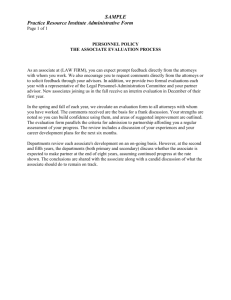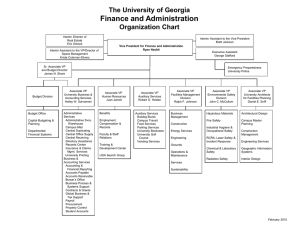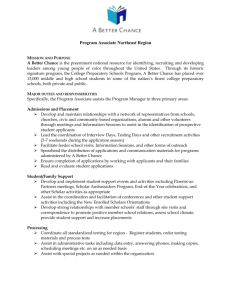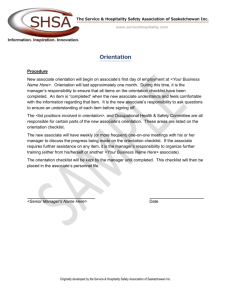AM_extract_from_the_..
advertisement
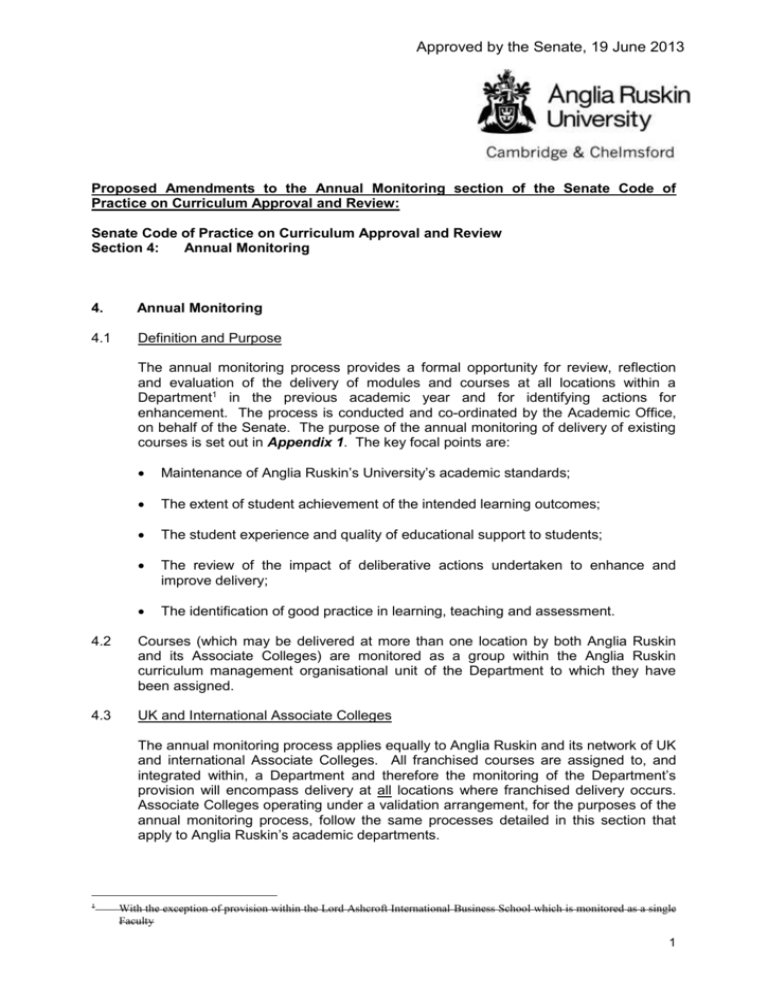
Approved by the Senate, 19 June 2013 Proposed Amendments to the Annual Monitoring section of the Senate Code of Practice on Curriculum Approval and Review: Senate Code of Practice on Curriculum Approval and Review Section 4: Annual Monitoring 4. Annual Monitoring 4.1 Definition and Purpose The annual monitoring process provides a formal opportunity for review, reflection and evaluation of the delivery of modules and courses at all locations within a Department1 in the previous academic year and for identifying actions for enhancement. The process is conducted and co-ordinated by the Academic Office, on behalf of the Senate. The purpose of the annual monitoring of delivery of existing courses is set out in Appendix 1. The key focal points are: Maintenance of Anglia Ruskin’s University’s academic standards; The extent of student achievement of the intended learning outcomes; The student experience and quality of educational support to students; The review of the impact of deliberative actions undertaken to enhance and improve delivery; The identification of good practice in learning, teaching and assessment. 4.2 Courses (which may be delivered at more than one location by both Anglia Ruskin and its Associate Colleges) are monitored as a group within the Anglia Ruskin curriculum management organisational unit of the Department to which they have been assigned. 4.3 UK and International Associate Colleges The annual monitoring process applies equally to Anglia Ruskin and its network of UK and international Associate Colleges. All franchised courses are assigned to, and integrated within, a Department and therefore the monitoring of the Department’s provision will encompass delivery at all locations where franchised delivery occurs. Associate Colleges operating under a validation arrangement, for the purposes of the annual monitoring process, follow the same processes detailed in this section that apply to Anglia Ruskin’s academic departments. 1 With the exception of provision within the Lord Ashcroft International Business School which is monitored as a single Faculty 1 4.4 Process There are four stages to the annual monitoring process. These are outlined in brief in the table below, with more detail in subsequent paragraphs. Stage & timing Stage 1 (early October) Department Core provision Provision of information set (which covers both core and collaborative provision) to each Department by the Academic Office Associate College provision Provision of information set (which covers an Associate College’s provision only) to each Associate College by the Academic Office Preparation of a summary report by the Department for review by the QESC Faculty Annual Monitoring Panel Preparation of a summary report by the Associate College for review by its own Courses Management Committee Each Associate College Courses Management Committee meets to consider the summary report and to agree an action plan arising from the report Stage 2 Meeting of the QESC Faculty (October/November) Annual Monitoring Panel with each Department to consider the information set and Departmental summary report and to agree the Department action plan Meeting of the QESC Annual Monitoring Panel with selected Associate Colleges to consider the information set and Associate College report and to agree the College action plan Stage 3 (December) FQESS meet to: consider the summaries of relevant Department meetings and associated action plans; consider the summary reports from relevant Associate Colleges and associated action plans. Stage 4 (January) QESC Annual Monitoring Panel meets to: consider the summaries of all Department meetings and associated action plans; consider the summary reports of all Associate Colleges and associated action plans. The purpose of the above review is to draw out any items of institutional significance and to identify any actions required. 4.5 Stage 1 for Provision at Anglia Ruskin2 – Annual Review of the Department (early October) This stage occurs during the early part of October and comprises the provision by the Academic Office to the Department and the QESC Annual Monitoring Panel of a standard set of quantitative and qualitative information relating to the Department’s modules and courses as delivered at all Anglia Ruskin and Associate Colleges in the preceding academic year. The information set constitutes: 2 And Associate Colleges operating under a validation arrangement (see paragraph 4.3) 2 Quantitative information Module performance statistics for each location of delivery indicating: numbers of students on each module, module evaluation score, pass/fail rates, mean marks; Course performance statistics for each location of delivery indicating: numbers of students on each course, course retention and completion rates, award classification outcomes; NSS scores (and outcome from other surveys specific to students, eg the NQT survey for the Department of Education). Qualitative information External examiner reports for the preceding academic year and responses to issues raised; PSRB and other external reports related to the previous academic year (as agreed in advance with each Department/Faculty to ensure appropriate coverage); NSS free text comments; Courses Management Committee minutes for the preceding academic year; Associate Colleges Courses Management Committee minutes for the preceding academic year as appropriate. 4.6 Stage 1 for Provision at Associate Colleges Operating Under a Franchise Arrangement – Annual Review of the Associate College (early October) This stage occurs during the early part of October and comprises the provision by the Academic Office to the Associate College of a standard set of quantitative and qualitative information relating to the Associate College’s modules and courses as delivered in the preceding year. The information set constitutes: Quantitative information Module performance statistics for the Associate College’s provision indicating: numbers of students on each module, module evaluation score, pass/fail rates, mean marks; Course performance statistics for the Associate College’s provision indicating: numbers of students on each course, course retention and completion rates, award classification outcomes; NSS scores where available (UK Associate Colleges only). Qualitative information External examiner reports for the preceding academic year and responses to issues raised; PSRB and other external reports related to the previous academic year ; NSS free text comments where available (UK Associate Colleges only); Courses Management Committee minutes for the preceding academic year; Courses Management Committee minutes for the Associate College for the preceding academic year. 4.7 Stage 2 for Provision at Anglia Ruskin3 – QESC Faculty Annual Monitoring Panel Meeting (October/November) This stage occurs during October/November and comprises the following: 3 And Associate Colleges operating under a validation arrangement (see paragraph 4.3) 3 4.7.1 Departmental response The Head of Department leads the scrutiny by Department colleagues, liaising with colleagues at Associate Colleges where relevant, of the standard information set with a view to drawing out the key trends evidenced by the various items provided by the Academic Office. The Department is also asked to put forward details of: how improvements through the data sets have been achieved through deliberative actions; relevant research and scholarly activity being undertaken by Department staff that will support the Department’s learning, teaching, and assessment strategies; any commendable achievements and/or features of good practice4 in learning, teaching and assessment for consideration by the Panel meeting and; details relating to any specific themes determined for each annual monitoring period. The Head of Department completes a brief summary (6-10 pages) of the conclusions to be drawn and details of any actions already in train to address any issues highlighted, or any actions proposed for the future. The summary is provided to the Academic Office for circulation to the QESC Annual Monitoring Panel at least one week in advance of the review meeting. 4.7.2 QESC Faculty Annual Monitoring Panel Meeting During late October/November, the Faculty/Dean’s office (in liaison with the Academic Office) Academic Office arranges a Faculty Annual Monitoring Panel two-hour meeting for each Department with key Department representatives such as the Head, Deputy Head (where relevant), Course Group Leaders and the Dean and/or Deputy Dean (with responsibility for quality assurance) with the QESC Annual Monitoring Panel to discuss the conclusions to be drawn from the information set and the Department’s response and proposed set of actions. A standard agenda, prepared by the Academic Office is used as the basis for each meeting and may be revised to accommodate the specific characteristics of each Department. Membership of the QESC Faculty Annual Monitoring Panel is as follows: 4 Dean Deputy Vice-Chancellor (Academic), Chair Director of the Academic Office, Vice-Chair or nominee A further senior representative of the Academic Office 1 senior representative, eg Head of Department from another Faculty Secretary: Faculty Quality Assurance Officer, (for meetings with Department) Senior Academic Office representative, Secretary (for final institutional level meeting) The Anglia Ruskin definition of good practice, is as follows: "a method, strategy, system, procedure or process, which has, over an appropriate period of time, resulted in improved academic standards, an enhanced quality of education and/or an improved level of service to stakeholders (eg: students, staff, external examiners, Associate Colleges, employers etc.) and which can, when appropriately adapted, be implemented in other areas of the institution. Such good practice can be evidenced in a variety of ways. Examples include student performance, statistical information, feedback from stakeholders (ie: via questionnaires, Courses Management Committee meetings, Employer Liaison Panel meetings etc.)”. 4 The quorum of the Panel is three members and includes either the Chair or Vice-Chair. The Secretary produces a report of each meeting highlighting the agreed action points for the Department. The Head of Department produces a Departmental action plan which forms part of the formal record of the meeting. 4.8 Stage 2 for Provision at Associate Colleges Operating Under a Franchise Arrangement – Courses Management Committee Meeting (October/November) This stage occurs during October/November and comprises the Associate College’s consideration of the information set and the preparation of a summary (to a standard proforma provided by the Academic Office) for consideration by the Semester/ Trimester 1 Courses Management Committee meeting which is responsible for agreeing actions arising from the summary. The Academic Office will arrange Associate College Annual Monitoring Panel meetings with those Associate Colleges who deliver ten or more courses and/or have student headcount of 500+. The meeting will consider the information set and Associate College report and agree the College action plan. Membership of the Associate College Annual Monitoring Panel is as follows: Deputy Vice-Chancellor (Academic), Chair Director of the Academic Office, Vice-Chair A further senior representative of the Academic Office 1 senior representative, eg Head of Department from Faculty(ies) with franchised provision delivered by the Associate College Secretary: provided by the Academic Office. Faculty Link Tutors to be invited as observers The quorum of the Panel is three members and includes either the Chair or Vice-Chair. The Secretary produces a report of each meeting highlighting the agreed action points for the Associate College. 4.9 Stage 3 - Faculty Level Scrutiny: FQESS Meeting (December) 4.9.1 The FQESS meets in December to consider the reports of each QESC Annual Monitoring Panel meeting and the associated action plans drawn up by the Department. The purpose of this review is to consider whether the action plans are appropriate and if there are any Faculty-wide matters that require additional attention. 4.9.2 The FQESS also receives copies of reports and associated action plans prepared by Associate Colleges involved in delivering the Faculty’s provision in order to draw out any Faculty actions required either specific to an Associate College or in relation to collaborative activity as a whole. 4.9.3 The March meeting of the Faculty Board receives a report from this meeting, together with updated versions of the Departmental action plans. 4.9.4 The final FQESS meeting of the academic year receives further updated Department action plans. 5 4.10 Stage 4 – Institutional Level Scrutiny: (January) 4.10.1 The QESC Annual Monitoring Panel meets to review: the summaries of all QESC Annual Monitoring Panel meetings and the associated action plans drawn up by the Departments; the reports and associated plans provided by Associate Colleges operating under a franchise arrangement. the minutes of the FQESS meetings; the summaries of all QESC Annual Monitoring Panel meetings for Associate Colleges operating under a validation arrangements and the associated action plans; 4.10.2 The purpose of the above review is to draw out any items of institutional significance and to identify any actions required. 4.10.3 The Head of Quality Assurance prepares an overall summary of the process and its outcomes for the attention of the February meetings of both the QESC and the Senate, highlighting any institutional level actions that are required. Caroline Watts Head of Quality Assurance Academic Office Performance Data 6


